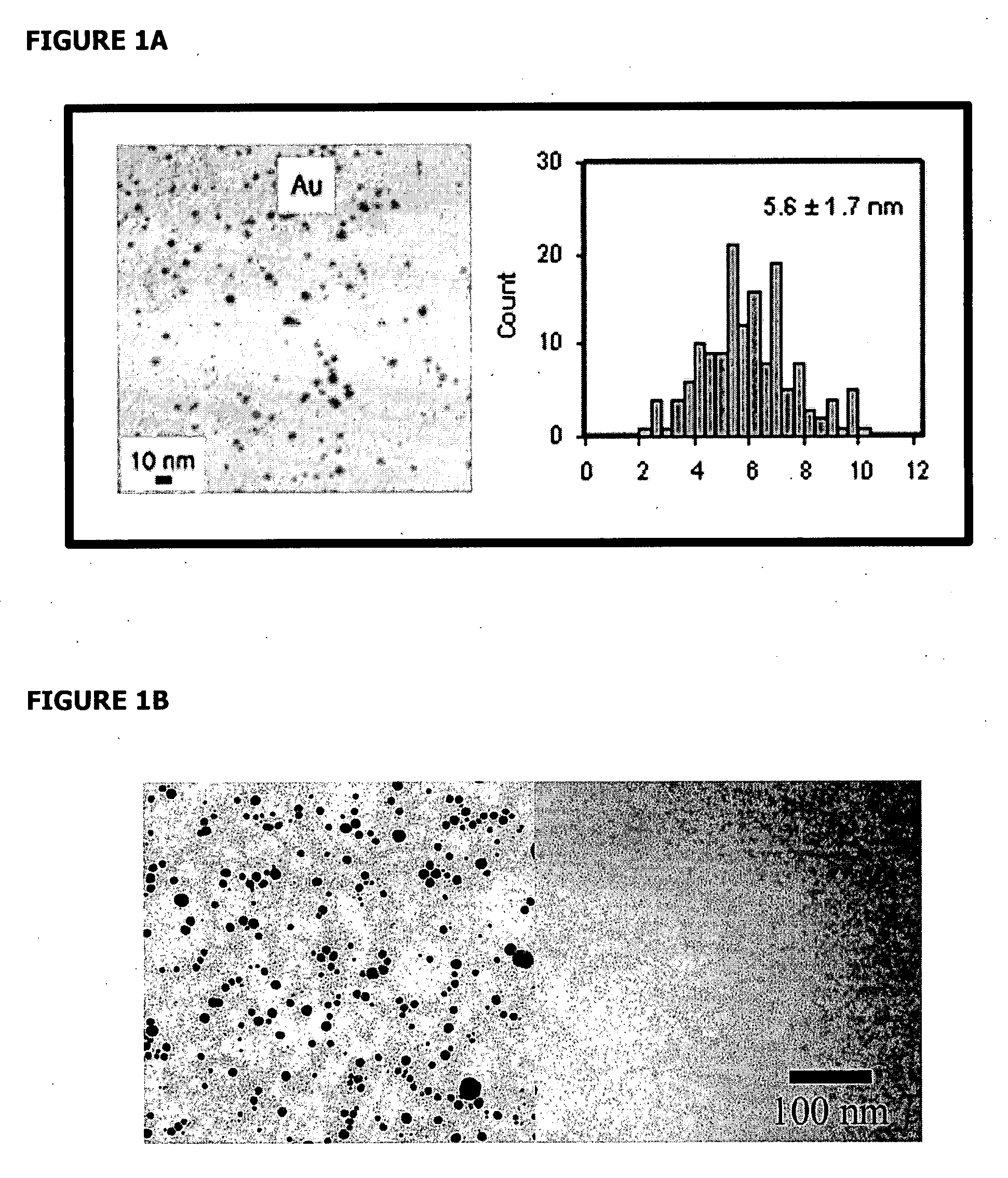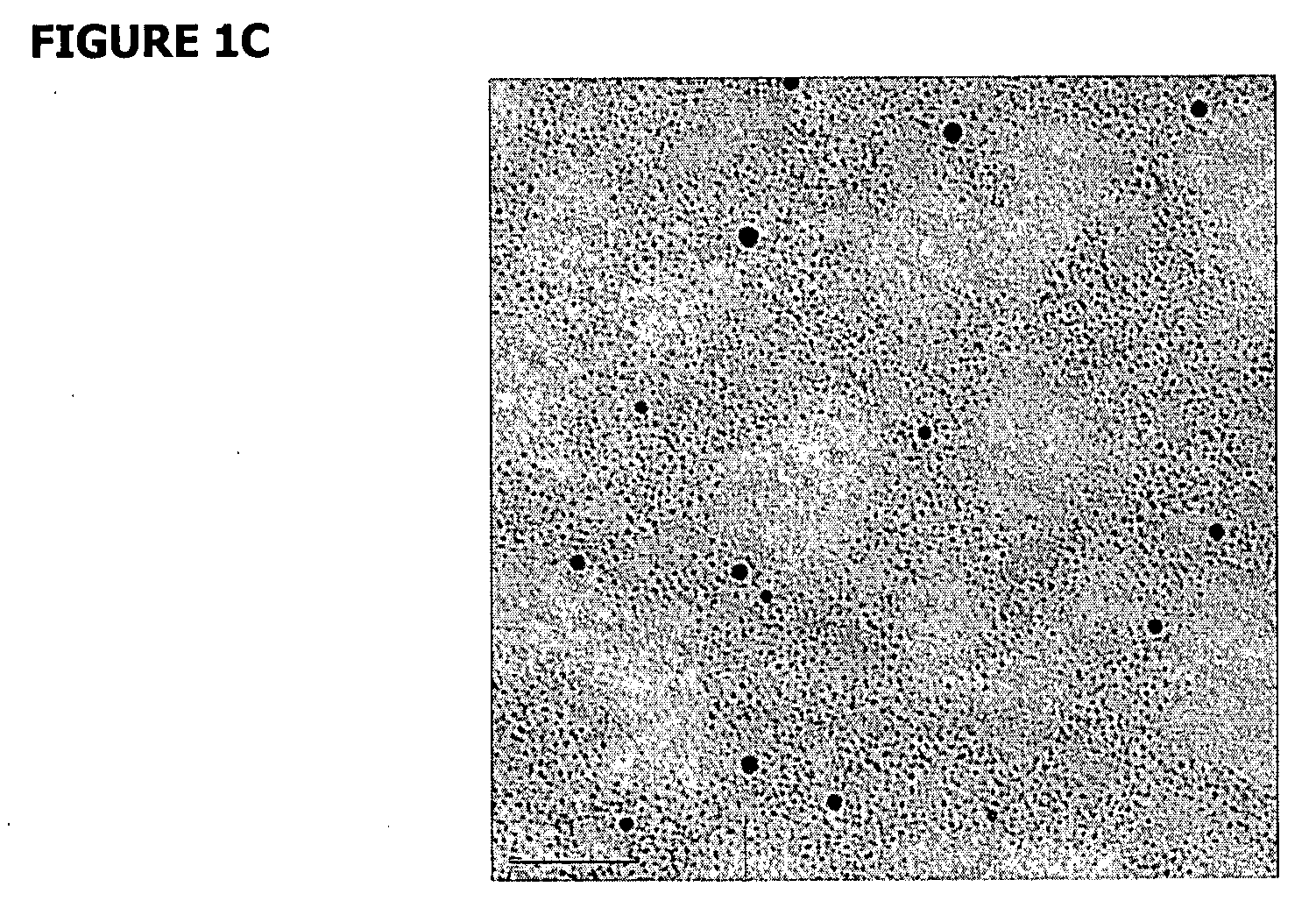Nanoparticle radiosensitizers
a radiosensitizer and nanoparticle technology, applied in the field of nanomaterials, can solve the problems of difficult clinical implementation, anti-enhancement and other side effects, damage to dna, cellular membranes or other targets, etc., and achieve the effects of enhancing specificity, enhancing x-ray absorption, and enhancing the specificity of both detection and treatmen
- Summary
- Abstract
- Description
- Claims
- Application Information
AI Technical Summary
Benefits of technology
Problems solved by technology
Method used
Image
Examples
example 1
The Use of Gold Nanoparticles to Enhance X-Ray Absorption
[0094] Materials and Methods
[0095] Synthesis of TMAnAuNP:
[0096] Dodecanethiol (C12) functionalized gold nanoparticles (AuNP), NNN trimethyl(11-mercaptoundecyl) ammonium chloride ligands, and trimethylammonium (TMA) C12 functionalized gold nanoparticles (TMAnAuNP, n denotes the number of TMA ligands on a nanoparticle) were synthesized using the available procedures (Tien et al., 1997, Brust et al., 1994, McIntosh et al., 2001). Different reaction times (24-hour or 51-hour) were used in the ligand exchange reactions to make TMAnAuNP, which yielded different n values. NMR and UV-VIS were used to verify the reaction intermediates and products.
[0097] 1.2% and 0.8% Agarose E-gels (Invitrogen) and Agarose gels prepared in the lab were used to detect supercoiled DNA, gold nanoparticles, and their complexes. The running conditions were between 50 or 60 V for 45 min (E-gels) or 3 hours (self-poured gels). Gels w...
example 2
Use of Gold Nanoparticles for Local Enhancement
[0114] Gold nanoparticles conjugated to scDNA using an ethidium-based intercalating ligand were used. In this experiment, 3-nm gold nanoparticles covered with a mixture of ethidium thiol ligands (<10 per nanoparticle) and charge-neutral surfactants were prepared. The charge-neutral ligands were used to avoid any DNA aggregation. Such a small amount of ethidium in the samples (<150 nM) did not result in any detectable change to the scDNA. Tris buffer was added to control the diffusion distance of hydroxyl radicals in water (Hodgkins et al., 1996). The ratio of nanoparticles to scDNA was ˜10. FIG. 12A shows a transmission electron microscope (TEM) image of nanoparticle-conjugated scDNA in which all the nanoparticles are conjugated to scDNA. FIG. 12B shows the results of DNA damage as a function of buffer concentration, which directly controlled the diffusion distance of OH radicals. At low buffer concentrations the enhancement was nearly...
example 3
Use of Gold Nanotubes for Remote Enhancement
[0115] Remote enhancement may be demonstrated using gold nanotubules (Qu et al, 2006). In this demonstration, scDNA was mixed with a matrix of ˜20 mg ligand-free gold nanotubules in 20 μl of water, as shown in FIG. 13A. The ratio of the weight of these gold nanotubules to water in the scDNA samples was ˜1:1. Because the shell thickness of the gold layer was about 40 to 70 nm, only high energy photoelectrons could escape the nanostructures. The gaps between these nanotubules were of the order of several hundred nanometers and scDNA could easily move through the matrix. This creates a mismatch between the penetration distance (many microns) of high energy photoelectrons and the distance between the nanotubules, which leads to the re-absorption of those photoelectrons by gold nanotubules. A factor 2 reduction in enhancement was found with the gold nanotubule case because many low energy electrons cannot escape the nanotubules. The re-absorpt...
PUM
| Property | Measurement | Unit |
|---|---|---|
| Fraction | aaaaa | aaaaa |
| Fraction | aaaaa | aaaaa |
| Length | aaaaa | aaaaa |
Abstract
Description
Claims
Application Information
 Login to View More
Login to View More - R&D
- Intellectual Property
- Life Sciences
- Materials
- Tech Scout
- Unparalleled Data Quality
- Higher Quality Content
- 60% Fewer Hallucinations
Browse by: Latest US Patents, China's latest patents, Technical Efficacy Thesaurus, Application Domain, Technology Topic, Popular Technical Reports.
© 2025 PatSnap. All rights reserved.Legal|Privacy policy|Modern Slavery Act Transparency Statement|Sitemap|About US| Contact US: help@patsnap.com



